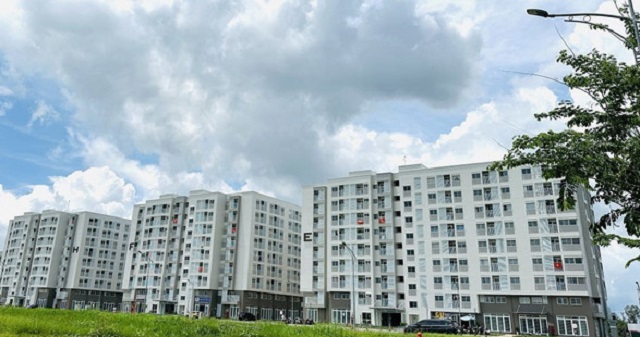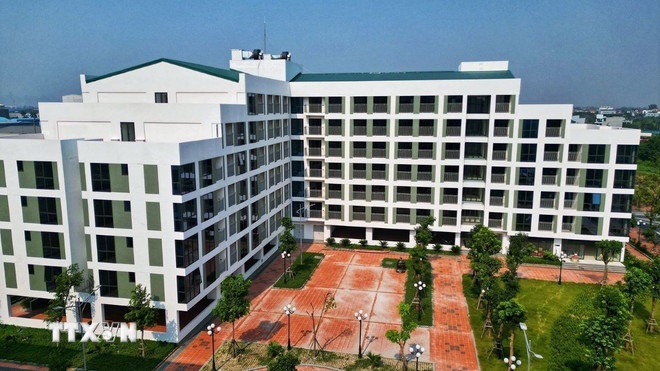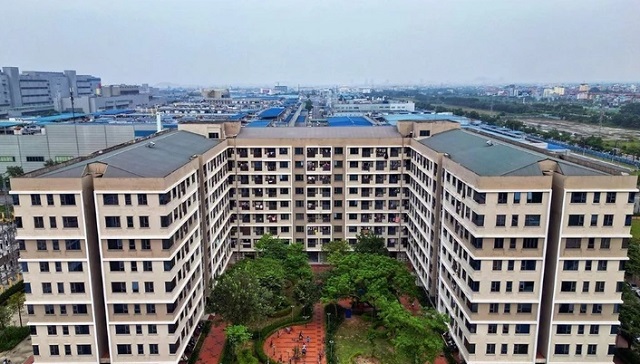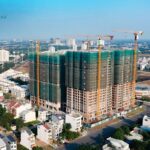
(Photo: Tuan Anh/VNA)
|
The People’s Committee of Ho Chi Minh City has outlined a plan to complete over 94,300 social housing units by 2030.
With numerous bottlenecks in social housing development, especially regarding policies and mechanisms, the city faces challenges in meeting this target without proactive involvement from authorities, businesses, and related parties to make social housing more accessible to low-income earners.
High Demand, Insufficient Supply
According to Vietnam’s Ministry of Construction, the country needs to build a minimum of one million social housing units by 2030 to meet the needs of its citizens, particularly industrial workers and low-income individuals. Ho Chi Minh City, with a population of over 9.5 million and a large migrant workforce, urgently needs affordable housing solutions.
In recent years, the city has invested efforts in developing social housing and worker accommodation projects to address the housing needs of the majority of low-income earners and workers affected by urban projects.
From the beginning of the 2021-2026 term to May 2025, the Ho Chi Minh City People’s Committee completed 2,745 social housing units. The city plans to finish an additional 2,874 units in 2025.
The People’s Committee and relevant departments have been working diligently to overcome legal and procedural obstacles for project implementation. However, it typically takes 3-5 years from the initiation of legal procedures to the completion and delivery of a project.
Ironically, while there is an oversupply of commercial and luxury housing in the city, social housing projects are scarce.
“In the context of Ho Chi Minh City, planning for social and low-income housing is always a pressing issue. However, the actual market supply is inadequate,” said Dr. Su Ngoc Khuong, Senior Director of Investment Consulting at Savills Vietnam.
Dr. Khuong noted that several completed social housing projects remain unoccupied due to insufficient technical infrastructure, social infrastructure, and urban economic factors. Additionally, volatile construction material prices and supply shortages have driven up social housing prices in the secondary market. Some units are advertised at double or triple their original price just a few years after delivery.
Regarding the reasons for the increase in social housing prices, Dr. Khuong stated that some governments worldwide have focused on developing social housing and implemented specific policies to ensure a sufficient supply for the market.

A social housing project. (Photo: Thanh Liem/VNA)
|
In Vietnam, the government has demonstrated its strong commitment to promoting social housing development through the Social Housing Scheme and the National Housing Fund. However, the massive demand and limited land resources make it challenging to meet the need. Additionally, the imbalance between supply and demand, along with inadequate planning, hinders social housing from reaching those who genuinely require it.
According to the standards set by the Ministry of Construction, the average housing area should reach 25-30 m2/person in first-tier cities, but this target has not yet been achieved.
The Ho Chi Minh City People’s Committee is developing the city’s housing development program for 2021-2030 (adjusted) and the housing development plan for 2026-2030, which includes social housing. The plan aims to increase the number of social housing units in subsequent years to align with the practical implementation of investment procedures for social housing projects in the city.
Unlocking Mechanisms Needed
According to economic experts, boosting social housing development requires focusing on core factors such as land funds, credit support, and streamlined investment procedures. Land acquisition costs should be accurately calculated, and interest rates should be reduced to facilitate the process.
Le Hoang Chau, Chairman of the Ho Chi Minh City Real Estate Association, stated that the mechanisms and policies related to social housing have become increasingly flexible and supportive of investors in this segment. However, he suggested that the National Assembly allow a pilot mechanism for “designating investors for social housing projects” to shorten the time required for administrative procedures and reduce legal compliance costs for both the state and investors.
“The 2023 Housing Law does not permit the People’s Committee at the provincial level to designate investors for social housing projects. Meanwhile, the current Construction Law and tax laws tightly control investment costs and profit margins for social housing projects, not exceeding 10%. Therefore, it is necessary to build a National Assembly resolution in this spirit,” Mr. Chau analyzed.
Additionally, according to Mr. Chau, establishing the National Housing Fund, including the Social Housing Development Fund, is essential for coordinating capital sources to promote the development of affordable housing, including social and commercial housing. This fund also serves as a tool to regulate the real estate market, ensuring its safe, healthy, and sustainable development.

There remain difficulties in implementing the project “Investing in building at least 1 million social housing units for low-income people and industrial workers in the period of 2021-2030” and solutions are needed from relevant agencies. (Photo: Tuan Anh/VNA)
|
For sustainable social housing development, Dr. Su Ngoc Khuong suggested clearly identifying the land fund and assigning it to investors based on key performance indicators (KPIs) agreed upon between the government and enterprises. Additionally, enterprises should receive support in legal procedures, credit, and profit margins.
“If these factors, especially capital and interest rate support for enterprises and eligible homebuyers, can be addressed, we can ensure a sufficient supply,” said Dr. Khuong.
“From a sociological perspective, the long-term consequences of social housing becoming unaffordable for citizens can lead to high social vices. In sociology, this is a challenging issue in developing countries,” Dr. Khuong remarked.
As the goal of building one million social housing units by 2030 is being promoted, removing legal, land, and financial barriers is crucial for the market’s proper direction. Social housing is not just an issue of welfare but should be viewed as part of a sustainable urban development strategy, ensuring that low-income earners have access not only to housing but also to living, learning, and working conditions./.
Anh Tuan
– 10:54 29/05/2025
“HCM City’s Credit Outstanding Reaches Nearly VND 4.1 Quadrillion by Late May”
As of the end of May 2025, Ho Chi Minh City’s outstanding credit balance is estimated to have reached VND 4.1 quadrillion, marking a 3.6% increase from the previous year and a significant 13.2% surge compared to the same period in 2024.
NewGen Invest – Strategic Distributor of Vinhomes Green City & Vinhomes Southern Region
NewGen Invest, a leading real estate investment firm, has reached new heights with its pivotal role in the distribution of Vinhomes Grand Park, an iconic development in the heart of Ho Chi Minh City’s vibrant eastern district. Now, the company has been entrusted yet again by Vinhomes as a strategic distributor for their newest project, Vinhomes Green City. This testament to NewGen Invest’s expertise and standing in the industry showcases their ability to consistently deliver exceptional results.
“Provincial Land Prices are on the Rise: Investors Eye the Market”
The land plots priced at 30-35 million VND per square meter in the vicinity of Ho Chi Minh City, such as Can Giuoc, Duc Hoa, Ben Luc in Long An, and Long Thanh in Dong Nai, are becoming scarce. Compared to the same period last year, land prices have surged by 10-25%, depending on the lot and location. The primary supply entering the market is currently very limited.





















